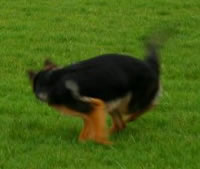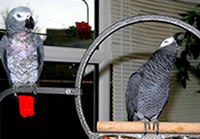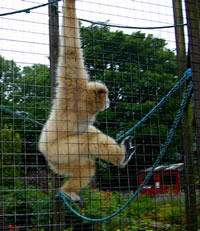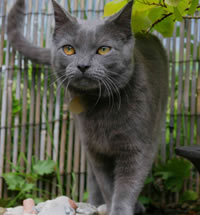|
Obsessive-compulsive disorder is a condition usually
related to humans, but stressed animals can suffer from
it too, especially cats and dogs. Dr David Sands explains
what it is and how we can help calm our pets down.
Constantly fussing,
always anxious, I am
observing a nervous animal
as she goes through a range
of ritualistic and repetitive
actions. Her condition is
recognised as obsessive-
compulsive disorder (OCD).
 Constant, repetitive
actions, such as
tail-chasing, may
indicate that your
dog has OCD
Constant, repetitive
actions, such as
tail-chasing, may
indicate that your
dog has OCD
And no, it’s not one of
my Border Collie
patients. This is my
sister who candidly
acknowledges
that she suffers from OCD.
One of the ways she deals
with anxiety and stress is
constantly ironing clothes.
Because it offers endlessly
repeated actions, known as
stereotypical behaviour, it
calms her mind. She finds that
her Yorkshire terrier, Tosh,
provides another stress
buster. Stroking and petting
him lowers her blood pressure
and heart rate.
In human terms, OCD,
thought to affect around
two per cent of the
population, is often triggered
by a major life event, trauma
or illness. But companion
animals, who cannot
understand the causes,
are also vulnerable
to stressful situations such
as changes in ownership,
moving homes (it means a territorial change to dogs and cats), or disruption of their family ‘pack’.
Bizarrely, Tosh the terrier, like my sister his owner, also suffers from OCD. It was the loss of the alpha female, Peppi, another Yorkie and leader of a ‘pack’ of three dogs, that triggered OCD in Tosh. He now grooms himself continuously and will even transfer his manic licking to Naz, the elderly Rottweiler. The two Yorkies were inseparable and since Peppi’s death, Tosh misses her leadership and has become anxious. To deal with his loss he obsessively grooms himself to sleep.
This is not at all unusual. All companion animals can show signs of OCD behaviour when they are stressed, either by problems experienced in the early socialisation period or during some time in their life. Dogs, as we have seen, over-groom, resulting in infected paws and bald patches. They can become incredibly destructive (in a previous Candis article I described how one dog chewed through a mattress), tail-chase or mess indoors. It’s also common for a stressed animal to develop a separation-related disorder, barking or crying excessively in an owner’s absence. I’ve also observed a young German Shepherd dog begin tail-chasing and, within moments, suffer a seizure state and collapse. A behaviour that at first may appear comical suddenly becomes sickening.
Over-grooming in cats results in severe fur loss and subsequent nasty skin conditions. The continual licking, chewing and grooming can result in a cat (or dog) developing lick granulomas or growths that can become very sore and eventually dangerous to health.
 Parrots may over-preen to help calm their nerves
Parrots may over-preen to help calm their nerves
In parrots, stress-related behaviour is manifested in feather plucking, over-preening and a range of repeated actions, which result in a rather sad-looking, bald bird. In horses, stress can lead to extreme behaviour including stable-door chewing or teeth grinding, causing mouth and teeth damage.
Visitors to zoos have all seen polar bears or big cats pace from one side of the enclosure to another. Some sway from paw to paw. All are performing stereotypical behaviour – any repeated, uncomplicated movement. For these animals the performance of repeated actions offers a calming effect in the brain that helps them to deal with their stress in
an unnatural situation. However, because the licking, chewing and grooming helps calm
the animal’s anxiety, performing the actions become even more necessary, even addictive. New research published in 2003 suggests
that the area or reward centre in the brain involved in feel-good hormones (serotonin and dopamine) also deals with addiction
and compulsion.
 Captive animals display repetitive behaviours to deal with stress.
Captive animals display repetitive behaviours to deal with stress.
Back home in the human zoo, my sister glides her top-of-the-range iron backwards and forwards and, in doing so, is acting out
a parallel form of behaviour. Just a few moments taken to observe patients – ordinary people like you and I who have found life temporarily difficult – on a hospital psychiatric ward would reveal similarly compulsive behaviour; the continual hand-wringing, rubbing arms or thighs or stroking their own faces repeatedly in an attempt to discharge anxieties in a physical way.
Obsessive compulsive disorder in humans is not sufficiently researched and even less so in animals. Why the condition develops in some individuals rather than others is not known. Neither is it conclusively agreed on how
to relieve the symptoms. Because animals cannot talk to us, we need to recognise the early signs of stress. It would then be easier to treat the insecurities and anxiety that leads to this destructive behaviour. Accordingly before treating animals suffering from OCD, my first priority is to help owners counter any stress factors that may have triggered the disorder.
The condition cannot be overcome by punishing or shouting, neither is excessive petting or special attention successful. These human responses simply reinforce the pet’s reactive behaviour. They may even suggest
to the animal (cats and dogs are sensitive to human moods) that the owner is also disturbed or anxious. Owner-attention given during bouts of stereotypical behaviour can advance the condition. The animal learns
that by performing the particular repetitive behaviour, attention will follow. We once filmed a dog that groomed excessively and discovered that he only started to lick when his owner came into the room. She would tell him to stop, giving him the attention he craved and reinforcing the behaviour.
 “Over-grooming in cats results in severe fur loss and subsequent nasty skin conditions. The continual licking and chewing can cause growths that become very sore”
“Over-grooming in cats results in severe fur loss and subsequent nasty skin conditions. The continual licking and chewing can cause growths that become very sore”
If you believe your pet is suffering from OCD, you should consult a veterinary and ask to be referred to an experienced and suitably qualified behaviourist. He will be able to calm the
animal with behavioural therapy. In simple terms,
reward signals are given when the behaviour has ceased
(clicker training, discussed in previous articles is great
for this) and non-reward signals (training discs or a
remote-controlled, citronella-filled, aversion collar)
given if the behaviour begins. This is usually effective.
There are, of course, drug therapies, such as
Prozac (a selective serotonin reuptake inhibitor, SSRI)
that can be used on animals as well as people suffering
from OCD. Unfortunately, they cannot treat the cause
of the condition. In some canine cases in which I have
been involved, these drugs have had damaging side
effects, triggering agitated and aggressive states.
Helping a pet suffering with OCD can take a great
deal of patience. If we understand the distress that is
the cause of their condition, we can empathise (but
not anthropomorphise) with their difficult behaviour.
Companion animals do not have a voice and need
someone to speak on their behalf.
Reader Letter
I avidly read all your animla articles in Candia but I am stumped by my dog's current behaviour. When I leave Tony, my Staffordshire bull terrier, at home when I go to work, why does he continually try to dig up the carpets? He has gone through one deep-pile carpet in several places?
It's like he is searching for something. Please help!
Suzanne Gallagher,
Wymundsley, Astley Village
Tony is probably very attached
to you and does not like to be
separated when you go to work.
We know from research that it is
not the length of time you are away
from your pet that causes this type
of behaviour, but the actual
separation. His frustration has
to have an outlet and he has
developed a displaced behaviour
(linked to the canine condition
called separation-related disorder)
to deal with his stress.
I have gone to some homes with
dogs that have this condition and
the back garden looks like a scene
from The Great Escape, with holes
almost everywhere. Dogs are
excellent at digging, scratching
and chewing and they can get into
a repetitive cycle (stereotypical
behaviour) when they start
to become manic. In his mind, Tony
is digging for rabbits and your
carpet replaces the earth he would
normally be digging up.
I would advise specialised
treatment for Tony. Speak to your
vet about this.
|







